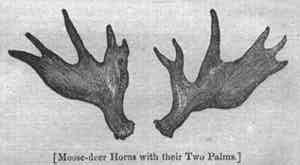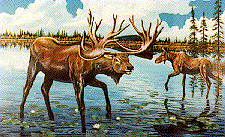 So how did the moose make it here today:
So how did the moose make it here today:
 So how did the moose make it here today:
So how did the moose make it here today:
The history of the moose dates back to around 1,000,000 BC to an old deer known as MEGACEROS. Two more recent relatives are described in detail on this page.
 The greatest collection of fossils of this kind can be found in the National History Museum in Dublin. The most impressive of which is shown here :-
The greatest collection of fossils of this kind can be found in the National History Museum in Dublin. The most impressive of which is shown here :-
The picture shows that like most modern deer the female was absent of antlers but unlike any deer today the antlers were of unbelievable size, up to 3.5m in span and almost 100lbs!!
Scientists agree that the giant deer most likely originated in Siberia and moved west due to the extreme temperatures. The extinction of the species is estimated at around 10,000 BC.
None of the deer of the present day can be compared in size to this Pleistocene fossil species. The Irish elk was a herbivore weighing over 800kg with a height of around 3m. The antlers were originally thought to be identical to those of the moose of North America, though much larger. They actually differ in several essential points -

The immense size of its antlers must have prevented it from inhabiting the dense forest. Instead it must have dwelt on heath-clad hills, there, armed with the most powerful weapons of self-defence, against the assaults of any single aggressor.
Did man co-exist with this animal in its native land? Most probably, yes. A head of the fossil elk, together with several urns and stone hatchets, were discovered in the same German drain. But what is still more conclusive is a rib in the Royal Dublin Society, evidently having been wounded by some sharp instrument. It remained long fixed in the wound and had not penetrated so deep as to destroy the creature's life. This was considered to be such a wound as the head of an arrow would produce.
No certified opinion has yet been given for the demise of this great species. We only know it existed. Its history is buried beneath the shadow of years gone by.
The stag-moose was found in deposits in mid-western America that indicate that it probably preferred swamps, bogs, and other wetlands in environments like the tundra and spruce parklands. This habitat is similar to that preferred by the modern moose. In fact, the stag-moose probably led a very similar lifestyle. Unfortunately the stag-moose became extinct sometime between 11,000 and 10,000 years ago.
The colour image (below) is a reproduction of a painting at the Illinois State Museum.

... or return Home